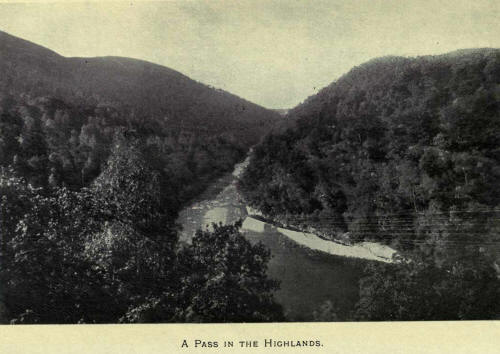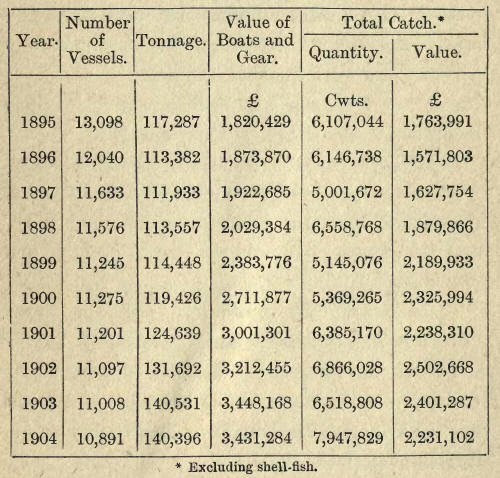|
WATER SUPPLIES
No conception can be formed
of the amount of energy running to waste from the lochs and streams of the
Highlands. There are enormous possibilities in this connection, and it is
quite possible that in the near future the whole of waterfalls and
high-level lochs in Scotland will be utilized for motive power in connection
with electric and other works, which must eventually inevitably gravitate to
regions where economy in natural energy is obtainable, to enable British
manufactories to compete successfully with foreign rivals.
No better proof can be
adduced than the great success attendant on the establishment of the British
Aluminium Company's Works at Foyers4 where an installation of water power
was established in 1895-1896, when two lochs have been impounded, making one
continuous stretch of water six miles long by half a mile in width, giving
sufficient storage to run the entire plant of the factory for fifty
continuous days and nights in the driest season, and capable of driving nine
turbines of 700 h.p. each.

So unobtrusive are the works,
that one has almost to search for them, thus completely upsetting the,
outcry once raised against the anticipated desecration of the romantic
scenery of the Falls of Foyers.
On the contrary, the
picturesque little village and. residential homes of the staff have, if
anything, enhanced the charming scenery of this locality, as. well as adding
an important factor to the economy and commerce of the district.
The utilization of the rise
and fall of the tide along our sea board is nothing new, for we find that a
"salt water mill" was in existence at Munlochy 100 years ago.
The tidal water was impounded
in a dam by means of simple self-acting sluices, and retained in the dam
until the tide ebbed, when the water was used to drive the water wheel, but
now that powerful turbines can be used a considerable increase of energy may
be obtained.
LIGHT RAILWAYS
SINCE the passing of the
Light Railways Act in 1896, the number of Orders confirmed by the
Commissioners was 234, representing 1552 miles of railway.
Of this mileage, only 791
miles apply to the Highlands of Scotland, representing six separate
undertakings, while out of the 79½ miles sanctioned only 45 miles have
actually been constructed. It will thus be seen that about 6 miles per annum
is the average mileage of railways carried out in the Highlands since the
inauguration of the Light Railways Act.
It is obviously clear that
the Highlands have benefited but very little in this connection, nor do I
suppose that any great developments will take place in this direction until
more liberal subsidies are granted by the Government, and the standard of of
construction considerably modified.
PEAT
CRUDE Peat contains about 85
per cent. of water, 13 per cent, of combustible material, and 2 per cent. of
inorganic substances. Of this, 80 per cent. can be got rid of or eliminated
by draining and evaporation.
Finished briquettes contain
no less than 66 per cent. of combustible material.
By carbonizing peat in
retorts, 3 tons produce I ton of peat coke, with valuable by-products of
gases, tar, methyl, alcohol, calcium, acetate, and ammonium sulphate.
In Russia, where coal is
expensive, peat coke is used to great advantage in lieu of coal.
FISHERIES
I append a tabular statement
from the 23rd Annual Report of the Fishery Board for Scotland.
SUMMARY
The following Table gives a
summary of the means of capture employed, and the resulting catch in
Scotland for the last ten years:—

It will be seen that the
progress during the above ten years has been gradual, although not so great
as would be desirable.
The total number of persons
engaged in connection with the Scottish Fisheries and allied industries was
88,000 in 1904, as compared with 86,000 in 1894.
Since the above was written,
a large number of "Steam Drifters"—a larger fishing craft propelled by
steam—has been introduced at several fishing-stations in the Moray Firth.
This is decidedly a step in the right direction, enabling the vessels to,
move rapidly after the fish shoals and avoiding the serious risk of getting
becalmed and the catch of fish damaged before reaching the curing station.
On many of the craft
ice-making plant is carried,, and small "shotts" of fish cured on board or
preserved in the ice chamber.
NOTES ON TREE PLANTING
I AM indebted to Sir Arthur
Bignold, M.P., for the following note on tree planting. Sir Arthur, an
enthusiast in this respect, between the years 1879 and 1896 has planted
eight million trees on his Lochrosque estate.
"The system now approved and
adopted in the North of Scotland is to allocate 4800 trees to each acre.
According to the altitude of the ground, so the result: but where protection
to the plantation has been secured, not only by fencing, but also by fire
trenches, and where also the trees have been planted under the supervision
of an experienced gaffer, the average result of two-year-old trees is a
production of 95 per cent, of those embedded.
"Again, the altitude of the
ground comes in: when the thinning moment arrives, each tree has protected
its neighbour from the wind, and, therefore, an unneccessarily close
construction is desirable in order that those which are left at thinning
time may have the benefit of the warmth contributed in their earlier years
by the contiguous trees it had been determined to remove. The victims come
in serviceably for use in forming arbours, wood houses, and decorations.
Practically the only suitable firs are the P. Sylvestris Scotch fir, the
spruce, and the larch; the latter being the only one deciduous conifer in
Great Britain. The spruce is in reality of no more than ornamental service,
but the larch pole is valuable, and is steadily increasing in demand.
Fifteen years from the date
of plantation is on the average the moment to begin the thinning, and at
twenty-five years the trees become of commercial value : all the expense
entailed is the cost of the tree plants (12/6 per 1000), the cutting of
catch-water drains, and the erection of the fence, and, say a twenty-foot
fire trench at the back of the fence. This being done, the proprietor can
limit his part to watching the growth of his wood, while nature completes
her work.
The essential point, never to
be lost sight, is, how high up the hill you will go. The attempt at Ardross,
some thirty-five years ago, at an altitude of 1000 feet, has demonstrated
the impossibility of success at that elevation, for these trees are now,
though still alive, no higher than six feet from the ground. The advantages
of protection from game and deer, which the woods afford, ought not to be
ignored in a Highland district, and strangely, almost inexplicably, the
creation of the wood has brought with it the reproduction of animals almost
extinct in the Highlands: the badger, and even the marten cat as well as the
wild cat, have reappeared in the North, and the rain has been deflected, and
the temperature appreciably lowered.
"Of course, these artificial
woods do not reproduce the Scotland of the past with its `shaggy wood,' to
which Sir Walter Scott refers, or
'The copse wood grey,
Which waved and wept
On Loch Achray.'
Nor has any attempt been made
to renew the rowan, the seeds of which, scattered by the wind, continue to
reproduce the parent tree, until they are eaten down by the sheep: nor the
natural, though ornamental, wood of ancient Ross-shire, which boasted not
only the holly (the chuillinn), the alder (the phearna), the willow (the
shellach), the oak, the hawthorn, the aspen, and the hazel, thousands of
which still remain, and are cherished by all true foresters."
Of all the countries of
Europe the United Kingdom is that with the smallest proportion of woodland.
It is, therefore, all the more imperative,, owing to the threatened failure
of the world's wood supply, that advantage should be taken of the thousands
of acres of land in the Highlands so admirably adapted for the growing of P.
Sylvestris.
The effect of afforestation
on the climate, public health, or landscape, as well as the length of time
to mature any large scheme on a purely commercial basis, is such that very
few private individuals can undertake such an extensive scheme as is
absolutely necessary to make the undertaking a success. It is, therefore,
all the more necessary that the Government should undertake the work, either
by acquiring by purchase outright suitable areas of land, which is neither
suited for agricultural nor grazing lands, and carry out extensive planting,
which in after years will be a source of income to the State, and make us
independent of imported timber for commercial and domestic purposes. |

